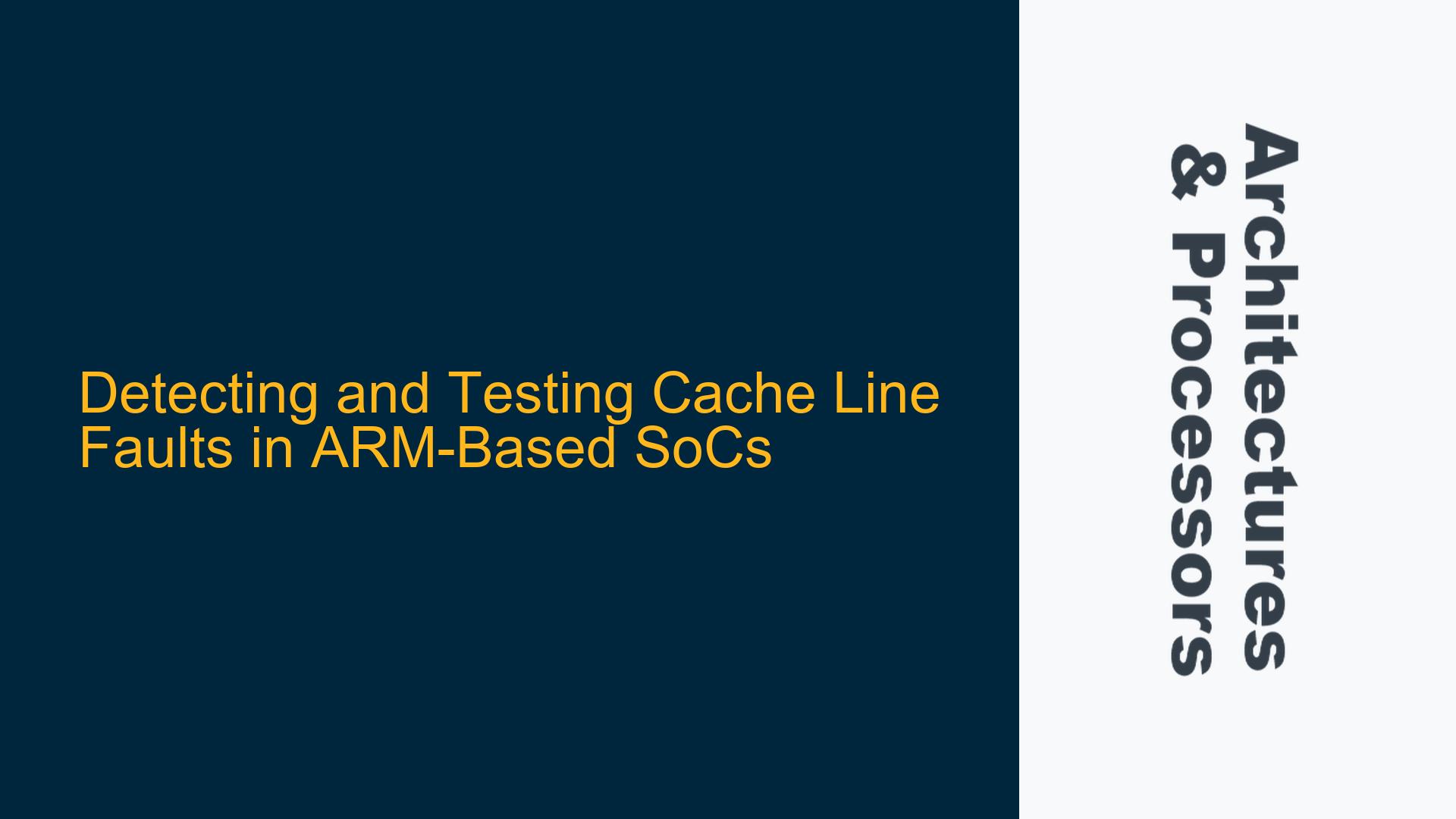Cache Line Faults and Their Impact on ARM-Based SoC Performance
Cache line faults, often referred to as "bad bits," can significantly degrade the performance and reliability of ARM-based System-on-Chip (SoC) designs. These faults can manifest as calculation errors, process failures, or even system crashes, particularly in scenarios where data integrity is critical. The cache memory, being a high-speed volatile memory, is prone to various types of faults, including stuck-at faults, transition faults, and coupling faults. These faults can occur due to manufacturing defects, aging, or environmental factors such as temperature and voltage variations.
In ARM-based SoCs, the cache is typically organized into cache lines, which are the smallest units of data that can be transferred between the cache and the main memory. Each cache line consists of multiple bits, and a fault in even a single bit can lead to incorrect data being processed by the CPU. This is particularly problematic in applications where data integrity is paramount, such as in automotive, aerospace, and medical devices.
The impact of cache line faults can be exacerbated in multi-core systems where cache coherency must be maintained across multiple cores. In such systems, a fault in one cache line can propagate to other cores, leading to widespread data corruption. Therefore, detecting and mitigating cache line faults is crucial for ensuring the reliability and performance of ARM-based SoCs.
Potential Causes of Cache Line Faults in ARM-Based SoCs
Cache line faults in ARM-based SoCs can arise from a variety of sources, each with its own set of challenges for detection and mitigation. One of the primary causes is manufacturing defects. During the fabrication process, imperfections in the silicon wafer or photolithography errors can lead to faults in the cache memory. These defects may not be immediately apparent and can manifest only under specific operating conditions.
Another significant cause of cache line faults is aging. As the SoC operates over time, the transistors and interconnects within the cache memory can degrade due to electromigration, hot carrier injection, and other aging mechanisms. This degradation can lead to an increase in the number of faults over the lifetime of the device, making it essential to implement robust testing and fault tolerance mechanisms.
Environmental factors such as temperature and voltage variations can also contribute to cache line faults. High temperatures can accelerate the aging process, while voltage fluctuations can cause timing violations and data corruption. In addition, radiation-induced soft errors, particularly in space and high-altitude applications, can cause transient faults in the cache memory.
The complexity of modern ARM-based SoCs, with their multi-level cache hierarchies and advanced power management features, further complicates the detection and mitigation of cache line faults. For instance, power gating and clock gating techniques, while effective in reducing power consumption, can introduce additional timing constraints and potential fault scenarios.
Comprehensive Strategies for Detecting and Mitigating Cache Line Faults
Detecting and mitigating cache line faults in ARM-based SoCs requires a multi-faceted approach that combines hardware, software, and system-level techniques. One of the most effective methods for detecting cache line faults is to perform direct read and write operations to the cache memory. This can be achieved by accessing the cache lines directly through their physical addresses, bypassing the virtual memory system. By writing known patterns to the cache lines and then reading them back, it is possible to identify any discrepancies that indicate the presence of faults.
Another approach is to manipulate the mapping between virtual and physical addresses to systematically scan each cache line. This technique involves adjusting the page tables and translation lookaside buffers (TLBs) to ensure that each cache line is accessed and tested. By iterating through all possible virtual address mappings, it is possible to cover the entire cache memory and identify any faulty lines.
In addition to these direct testing methods, it is essential to implement built-in self-test (BIST) mechanisms within the SoC. BIST circuits can be designed to automatically test the cache memory during power-on, periodic intervals, or in response to specific events. These circuits can generate test patterns, apply them to the cache memory, and compare the results to expected values, flagging any faults that are detected.
For multi-core systems, maintaining cache coherency is critical to preventing the propagation of faults. Implementing cache coherency protocols such as MOESI (Modified, Owned, Exclusive, Shared, Invalid) can help ensure that all cores have a consistent view of the memory. Additionally, using hardware-based error detection and correction (EDAC) mechanisms, such as parity checking and error-correcting codes (ECC), can help mitigate the impact of cache line faults.
At the system level, it is important to incorporate fault tolerance techniques that can handle transient and permanent faults. Redundancy, both in terms of hardware and software, can be employed to ensure that the system can continue to operate correctly even in the presence of faults. For example, redundant cache lines or entire cache banks can be used to replace faulty ones, while software-based error recovery mechanisms can help restore the system to a correct state.
Finally, comprehensive simulation and verification are essential for identifying and addressing potential cache line faults during the design phase. Using advanced verification methodologies such as Universal Verification Methodology (UVM) and SystemVerilog, designers can create detailed testbenches that simulate various fault scenarios and validate the effectiveness of the fault detection and mitigation mechanisms. By thoroughly testing the SoC under a wide range of conditions, it is possible to ensure that the final product is robust and reliable.
In conclusion, detecting and mitigating cache line faults in ARM-based SoCs is a complex but essential task that requires a combination of hardware, software, and system-level techniques. By implementing direct testing methods, BIST mechanisms, cache coherency protocols, EDAC techniques, and fault tolerance strategies, designers can ensure that their SoCs are capable of delivering high performance and reliability, even in the presence of faults. Comprehensive simulation and verification further enhance the robustness of the design, making it possible to identify and address potential issues before they manifest in the field.






